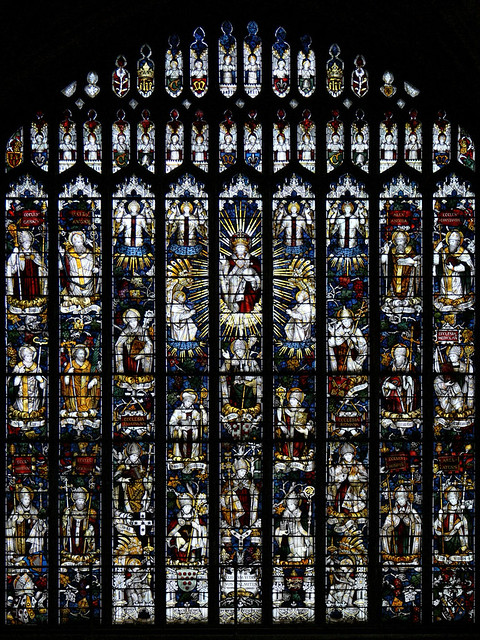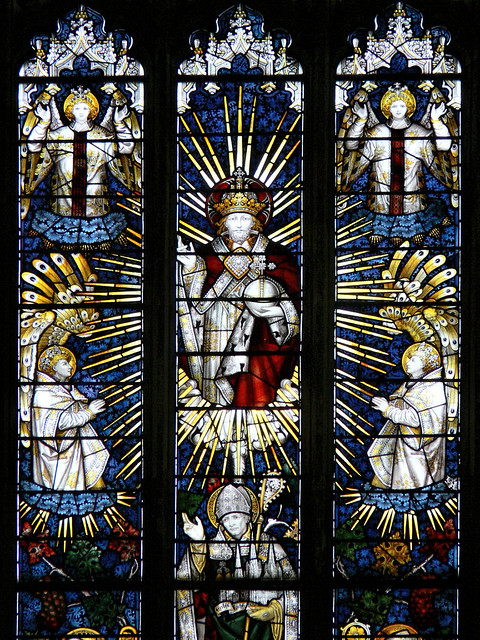Lichfield Cathedral - South Transept Window

The vast south transept window at Lichfield Cathedral is one of the most imposing works of High Victorian stained glass in the building. Installed between 1869 and 1873 as part of the 19th-century restoration campaign, it was designed and executed by the prolific Gothic Revival studio Clayton & Bell. Comprising nine tall lancets crowned by rich tiers of tracery lights, the window forms a complex yet coherent theological cycle centred on the Majesty of Christ and the ranks of heavenly and ecclesiastical witnesses.
Central Imagery

At the heart of the composition, occupying the central lancet, is Christ in Majesty seated within a radiant mandorla of golden rays. His right hand is raised in blessing while his left holds a book or orb, symbols of divine sovereignty. Angels kneel and stand in adoration around him, creating a celestial chorus that anchors the surrounding iconographic programme.
Flanking Figures
The lancets to either side are filled with angels, apostles, evangelists, bishops, prophets, and church fathers, each identifiable by their attributes and inscribed scrolls. Clayton & Bell’s characteristic use of white-robed angels, often given subtle silver-stain highlights, creates a luminous contrast with the deep cobalt grounds behind them. Saints such as Peter, Paul, Augustine, Jerome, and key English ecclesiastical figures appear in the lower tiers, reinforcing themes of apostolic succession and the historical continuity of the Church.
Lower Register
The lower lights contain standing figures of bishops and clerics, many holding scrolls inscribed ECCLESIÆ CATHOLICÆ or similar legends. Beneath these are heraldic shields, coats of arms, dedicatory panels, and decorative motifs that visually ‘ground’ the ascending hierarchy of ecclesiastical authority above.
Tracery Lights
The upper tracery includes:
-
small angels holding musical instruments or attributes of worship
-
heraldic shields, including diocesan arms
-
foliage and symbolic motifs
All framed within slender Gothic canopies emphasising verticality and lightness.
Iconographic Programme
The entire window constitutes a visual statement of:
-
Christ’s eternal kingship,
-
the praise of the heavenly host,
-
the unity of the Church across time,
-
and the continuity of English Christianity from apostolic foundations.
While not strictly narrative, the scheme draws on medieval precedents of the Majestas Domini, aligning Victorian ecclesiology with high-medieval models.
Stylistic Analysis
Clayton & Bell’s hand is unmistakable:
-
Deep, saturated colour fields (particularly cobalt blue and ruby).
-
Heavy use of silver stain for golden haloes, wings, and architectural detail.
-
Expressive but idealised facial drawing.
-
Dense compositions with minimal blank background.
-
Alternation of white and coloured robes for rhythm and brightness.
-
Linear painted shading used sparingly but effectively.
The window exemplifies the firm’s mature period, when large-scale cathedral commissions allowed for ambitious iconographic cycles and richly decorative glazing across multiple lights.
Historical Context
The window forms part of the extensive Victorian restoration at Lichfield led by Sir George Gilbert Scott in the mid-19th century. Clayton & Bell were Scott’s preferred glaziers for numerous cathedral projects, and their work at Lichfield stands among the most substantial of their cathedral-scale installations.
